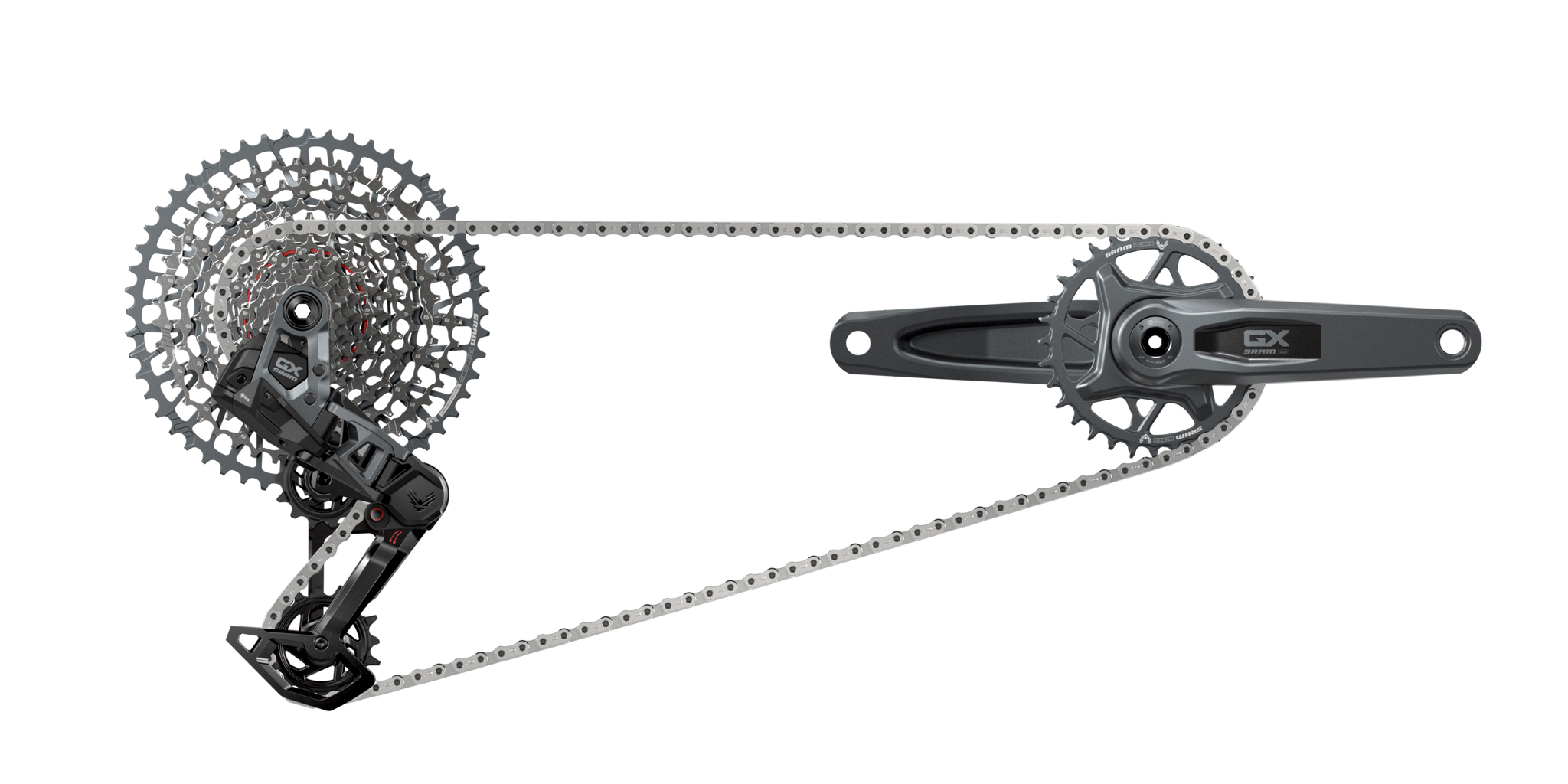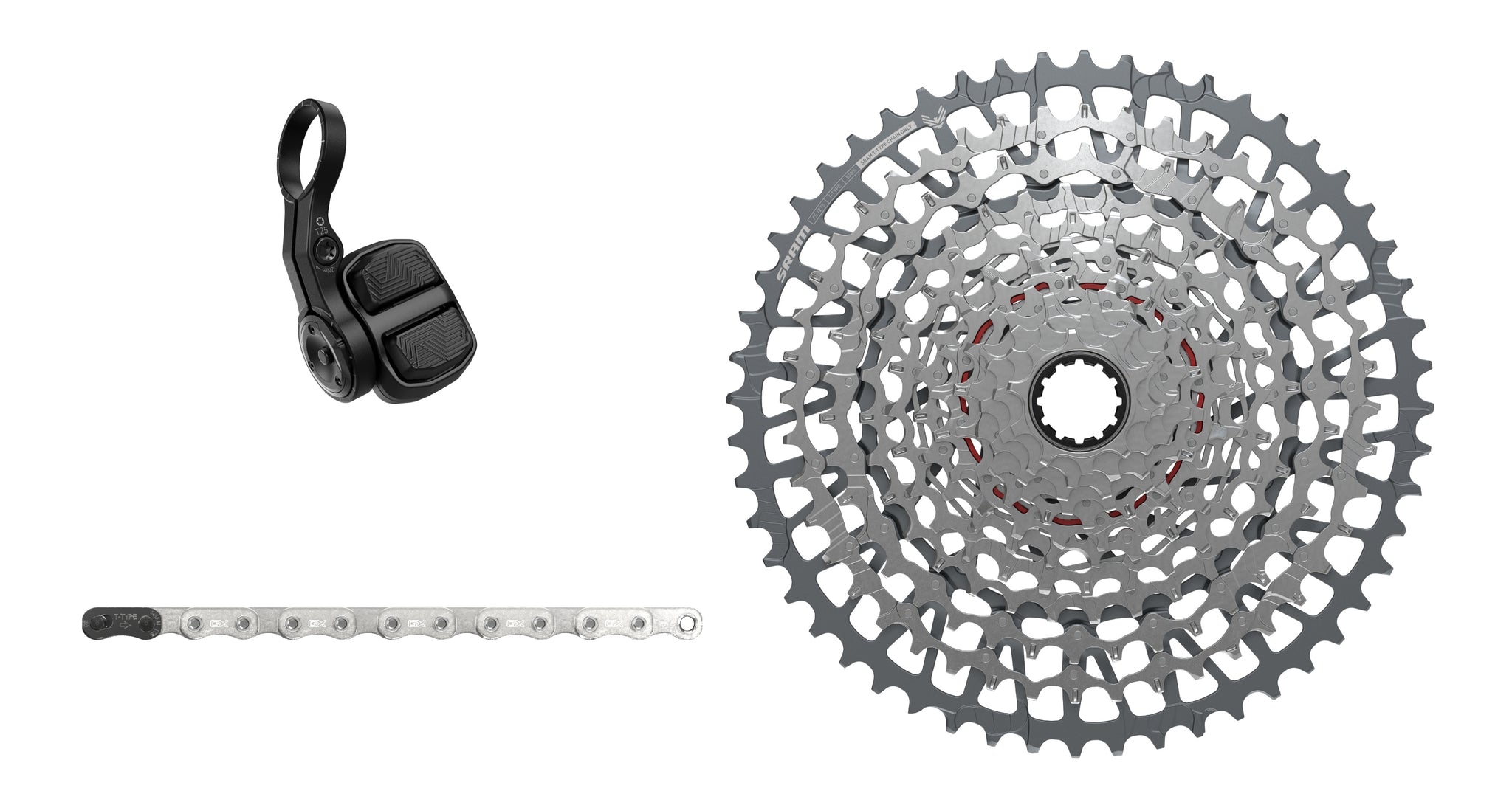SRAM’s new X0 and XX Eagle T-Type Transmission drivetrains were a major revolution in mountain bike drivetrains. Of course, as is the case with all new tech, the major downside was the high cost. The top-of-the-line XX SL Transmission retails for $2,700 (with a power meter) while the X0 Transmission retails for $1,600.
But now, SRAM is introducing the slightly more affordable GX Eagle Transmission which retails for $1,100. While it's still pricier than mechanical alternatives, GX Transmission should put the latest electronic drivetrain technology within the budget for more mountain bikers.
[button]Shop SRAM[/button]
SRAM GX Eagle Transmission Highlights

- GX Eagle Transmission is the most affordable groupset in the new T-Type Transmission lineup.
- GX Eagle Transmission maintains all the key features of the higher-end Transmission groups.
- The GX Eagle Transmission rear derailleur features a revised battery position.
- The XS-1275 T-Type cassette features a Pindome design for gears 1-8 and a single-piece MINI-CLUSTER for gears 9-12.
- The GX Eagle Transmission chain and cassette feature a nickel coating for more durability.
- The GX Eagle Transmission crank is not available with a DUB-PWR spindle-based power meter but can be upgraded with a spider-based power meter if desired.
- Groupset MSRP: $1,099.00
[button]Shop SRAM Transmissions[/button]
What’s New About SRAM GX Transmission?
 Really, there’s not much new tech to report. The major difference with GX Eagle Transmission is the use of more affordable materials in its construction. This means it will weigh more (the exact amount to be confirmed) than XX and X0 Eagle Transmission, but also cost $500-1,600 less. It is intentionally positioned to be the most popular option in SRAM’s new drivetrain line-up.
Really, there’s not much new tech to report. The major difference with GX Eagle Transmission is the use of more affordable materials in its construction. This means it will weigh more (the exact amount to be confirmed) than XX and X0 Eagle Transmission, but also cost $500-1,600 less. It is intentionally positioned to be the most popular option in SRAM’s new drivetrain line-up.
Like its predecessors, GX Eagle AXS and GX Eagle Mechanical, GX Eagle Transmission features the same technology used on SRAM’s higher-end offerings. All the interesting details about how SRAM’s T-Type Transmissions work will have already been covered with the initial release of the XX and X0 Transmissions this spring.
The basic gist is that the new direct-mount T-Type derailleur mounts directly to the frame and directly contacts the cassette. This eliminates the derailleur hanger and the need for adjustment screws. Because it’s stiffer and mapped to the cassette, you get super crisp and precise shifts, even under load. The derailleur is also designed to survive serious abuse (there are plenty of images and videos of people standing on the new T-Type derailleurs and hitting them with hammers). Replacement parts are available also, so it’s rebuildable if it does get damaged.
The T-Type direct-mount rear derailleur requires a frame with a UDH (universal derailleur hanger), which is a standard that has been adopted by many frame manufacturers in recent years. Since it’s a complete system, you need the full groupset (derailleur, chainring, cassette, and chain) for it to function. The T-Type chain is compatible with X-Sync Road chainrings, and the rear derailleur can connect with AXS road shifters, so you can create a mullet set-up for road and gravel use.
[button]UDH Compatible Bikes[/button]
While the technology, performance, and overall feel are largely the same, there are a few subtle differences with the new GX Eagle Transmission components when compared to XX and X0 Eagle Transmission.
GX Eagle Transmission Rear Derailleur
 The biggest difference is that the rear derailleur features a revised battery position. Instead of hanging directly off the back, the battery is now more hidden, tucked further into the body of the rear derailleur. Not only does this provide a clean new look, but it also keeps the battery protected from impacts. While I’ve never managed to knock an AXS battery off in a crash, this should provide some peace of mind for riders using this derailleur for gnarlier, gravity-oriented riding.
The biggest difference is that the rear derailleur features a revised battery position. Instead of hanging directly off the back, the battery is now more hidden, tucked further into the body of the rear derailleur. Not only does this provide a clean new look, but it also keeps the battery protected from impacts. While I’ve never managed to knock an AXS battery off in a crash, this should provide some peace of mind for riders using this derailleur for gnarlier, gravity-oriented riding.
Like the X0 Transmission rear derailleur, the GX version uses protective skid plates and a two-piece outer link that are replaceable if damaged. The pulley cage uses a steel inner cage (XX uses carbon, X0 uses aluminum) to add more robustness and reduce cost. The tool-free cage assembly can also be easily removed and upgraded if desired.
Note: Supposedly, the derailleur also has a “reconfigured gearbox.” I’m not 100% clear on what that means, whether that refers to the actual motor in the derailleur or something else, but I will update this when SRAM provides more information.
GX Eagle Transmission Crankset
 The GX Eagle Transmission crankset has the option to run two composite bashguards to protect the GX chainring (which comes in 30t, 32t, and 334t options) from rock strikes. The crank arms are forged aluminum, but they don’t feature a hollow machined section in the center like the X0 aluminum cranks. This will add some extra grams but reduces the overall cost.
The GX Eagle Transmission crankset has the option to run two composite bashguards to protect the GX chainring (which comes in 30t, 32t, and 334t options) from rock strikes. The crank arms are forged aluminum, but they don’t feature a hollow machined section in the center like the X0 aluminum cranks. This will add some extra grams but reduces the overall cost.
The only other thing to note about the GX crank is that there is no crank option with SRAM’s DUB-PWR spindle-based power meter. You can likely mix and match components and run an X0 power meter left crank arm with a GX right crank arm if you really wanted to. The crank, however, does use the SRAM’s 8-Bolt direct-mount chainring standard, so you can run a spider-based power meter.
GX Eagle Transmission Shifter, Chain, and Cassette
 As for the rest of the GX Eagle Transmission, it’s business as usual. GX uses the same AXS Pod shifter as XX and X0. The flattop 12-speed chain is the same design we’ve already seen. For GX, we get a nickel-plated chain with solid pins and links for more durability (and a bit more weight).
As for the rest of the GX Eagle Transmission, it’s business as usual. GX uses the same AXS Pod shifter as XX and X0. The flattop 12-speed chain is the same design we’ve already seen. For GX, we get a nickel-plated chain with solid pins and links for more durability (and a bit more weight).
The cassette is also nickel-plated and features the same 10-52t range as the XX and X0 cassettes, but the overall construction is a bit different. The cassette utilizes a PinDome design for gears 1-8 and a one-piece MINI-CLUSTER for gears 9-12. Again, the use of more pins and individual cogs in the cassette (versus the larger one-piece clusters found on the XX and X0 cassettes) increases weight but reduces cost.
SRAM Code and Level Bronze Stealth Brake

- SRAM Code Bronze Stealth - $185
- SRAM Level Bronze Stealth 4-Piston - $165
- SRAM Level Bronze Stealth 2-Piston - $108
But wait, there's more! This spring, SRAM also released its new Stealth Code and Level brakes. These new brakes changed the hose routing to bring it closer to the handlebars and simplified the SRAM brake line-up into two tiers: Ultimate and Silver. Apparently, that was too simple, because SRAM has now added a third tier: Bronze.
 As the name implies, it sits below Silver and provides a more affordable option for consumers. Bronze Stealth brakes will be around $80 less than Silver Stealth brakes (per brake). Bronze brakes also feature a Dark Polar Anodized finish that pairs specifically with GX Eagle Transmission.
As the name implies, it sits below Silver and provides a more affordable option for consumers. Bronze Stealth brakes will be around $80 less than Silver Stealth brakes (per brake). Bronze brakes also feature a Dark Polar Anodized finish that pairs specifically with GX Eagle Transmission.
Bronze Stealth brakes reduce cost by eliminating the bearing in the lever pivot. Code Bronze Stealth brakes also eliminate the contact adjust dial built into the lever body. All brakes still use tool-free reach adjust and come with metallic brake pads.
[button]Shop SRAM[/button]
Photos courtesy of SRAM.


















